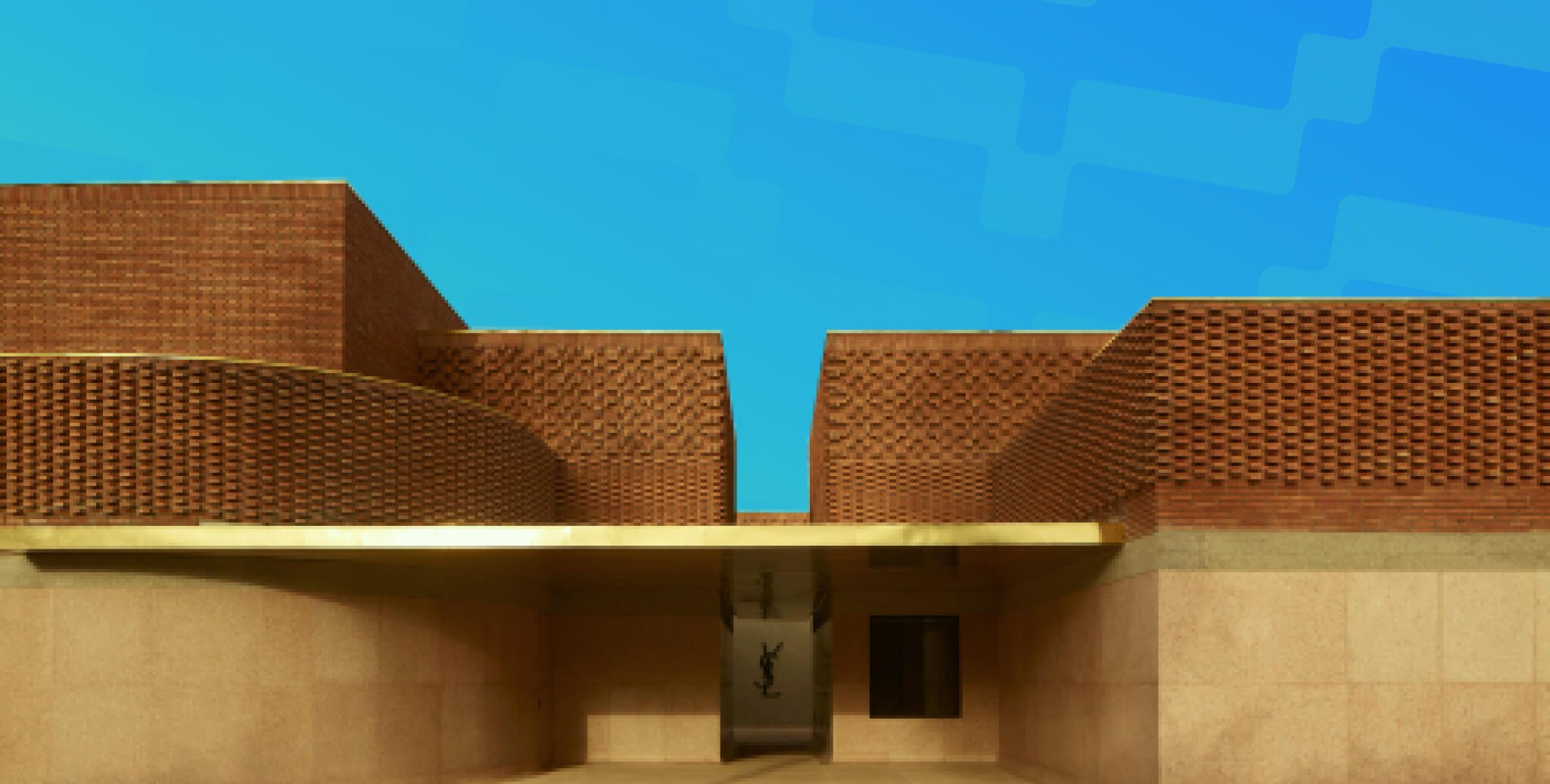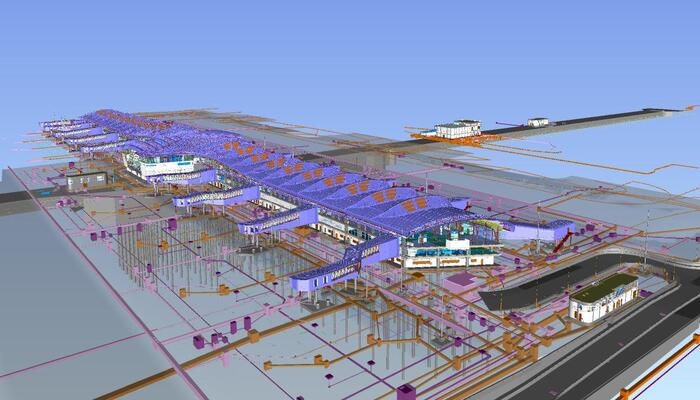The Future of BIM: How AI is Driving Innovation in the Industry 2025
Table of Contents
The AEC (Architecture, Engineering and Construction) industry has been experiencing a significant transformation due to technological advancements. Building Information Modelling (BIM), virtual reality, sustainable design practices, and the integration of Artificial Intelligence (AI) have been booming reshaping the AEC landscape. These advancements are enhancing efficiency and promoting inclusivity and streamlining workflows for a seamless project lifecycle.
When designing and constructing futuristic buildings, the goal is to create a future. This is where AI plays a crucial role—it helps design and create buildings that are modern, functional, sustainable, and pleasing to the eye. Read the blog to learn how AI in BIM will revolutionise the AEC industry.
What is Building Information Modelling?
BIM is a highly collaborative process that allows architects, engineers, contractors, and other consultants to plan, design and construct a structure or building collaboratively within one 3D model.
BIM integrates structures and multi-disciplinary data to produce a digital representation of an asset across its lifecycle. BIM offers an increased insight into the structure's construction process from scratch. When implemented correctly, BIM solves all concerns that might hinder the construction process like clash detections, errors, and required materials. Moreover, it can also help in creating multiple iterations of the same design layout.
Let’s have a look at the benefits of BIM tools in the AEC industry:
How Does BIM Benefit the AEC Industry?
-
Efficiency and Time-Saving: BIM significantly reduces the time required for clash detection, which takes several days to detect when done manually. BIM helps save time and extra cost.
-
Improved Visualisation and Risk Reduction: BIM technology enables multi-faceted visualisation of plans, providing a better insight into the project. It also uplifts the overall project quality, contributing to enhanced productivity, project life, reduced cost, and mitigated risk.
-
Enhanced Collaboration and Reduced Project Costs: BIM adoption enhances the collaboration process as it allows multiple project stakeholders to come together on one platform and share their feedback in real-time. It also reduces fragmentation in the AEC industry, leading to improved performance and reduced project costs, alongside having improved project quality.
-
Transformation of Workflows: BIM has emerged as a transformative technology, reshaping the way projects are conceptualised, designed, and executed in the AEC industry. It enhances collaboration, improves visualisation, supports efficiency in design and planning, and ultimately leads to cost savings and better lifecycle management.
Watch this video to understand the benefits of BIM in detail:
https://www.youtube.com/watch?v=UODDUz4ftZk&list=PLYM2O5rHb1ABXJK5TpMTGfMMWNzIM2E2J
Also Read: BIM Metamorphosis - A Paradigm Shift in the AEC Industry
What is Artificial Intelligence (AI)?
AI is not just any buzzword but is one of the biggest transitions in the human world. It is a set of technologies that enable humans to perform a variety of tasks and advanced functions, analyse data, and make recommendations. It is mainly concerned with building computers and machines that can reason, learn, and act in ways that will scale human analysis by a vast margin.
Benefits of AI-Driven BIM
AI is revolutionising processes and driving innovation across multiple industries. Here are some key benefits of AI in today’s world:
-
Increased Productivity and Efficiency: AI tools and technologies enhance productivity, reduce costs, and improve efficiency by automating repetitive tasks and streamlining processes. It enables organisations to achieve more with fewer resources.
-
Innovation and Creativity: AI tools are known to foster creativity and innovation. For instance, AI powers mobile apps that allow customers to see and consume content as per their preferences and demography.
-
Improved Decision-Making: When fed the right information without any biases, AI supports better decision-making by analysing that vast amount of data and providing valuable insights.
-
Cost Reduction and Profitability: AI enables organisations to achieve more with fewer resources, but that’s just one part of it. Since AI also aids in risk management, supports innovation, and helps detect errors in earlier stages, it leads to saving up the rework costs of any project.
-
Transformative in Nature: AI has the potential to transform industries permanently, optimising services, and improving quality of life. It is used for risk detection and better predictions, leading to significant improvements in the whole process for any industry.
Now, that we have a better understanding of both BIM and AI, let’s understand how their integration with one another is helping the construction industry.
How AI in BIM is helping the Construction industry?
AI in BIM is proving to be a game changer for the AEC industry. This integration offers a wide range of benefits that enhance efficiency, productivity and sustainability. Here’s a detailed version of how this integration of AI with BIM works:
- Design Optimisation and Planning: AI algorithms can easily analyse vast amounts of data within BIM models. This optimises design parameters such as energy efficiency, cost-effectiveness, and structural integrity. This leads to better-designed buildings that meet performance criteria while also minimising resource consumption and costs.
- Improved Clash Detection: Clash detection is a crucial aspect of construction planning that involves identifying conflicts between different building systems before construction begins. AI algorithms can analyse BIM models to help detect clashes more accurately and efficiently. This reduces the likelihood of errors during construction and minimises rework.
- Enhanced Project Management: AI-powered BIM platforms streamline project management processes by automating tasks such as scheduling, resource allocation, and progress monitoring. AI identifies potential delays or cost overruns early by analysing project data in real-time. This allows project managers to take proactive measures to mitigate risks and keep projects on track.
- Quality Control and Safety Monitoring: AI algorithms can analyse construction site data. Along with images and sensor inputs, to monitor quality and safety compliance. Moreover, AI can help prevent accidents and ensure that construction activities meet quality standards by detecting real-time deviations from specifications or safety protocols.
- Predictive Maintenance: AI in BIM enables predictive maintenance by analysing historical data and sensor inputs that have been fed into the building systems. Construction companies can schedule maintenance proactively, minimising downtime and reducing maintenance costs.
- Automated Documentation: AI helps in automating the generation of construction documentation from BIM models. This includes schedules, material quantities, and specifications. This automation reduces the time and effort required for manual documentation tasks, freeing up resources for more critical tasks.
- Energy Efficiency and Sustainability: AI algorithms can analyse building performance data within BIM models to optimise energy usage and reduce environmental impact. By identifying opportunities for energy savings and recommending design iterations, AI integrated with BIM contributes to the creation of more sustainable buildings.
- Enhanced Collaboration and Communication: AI-powered BIM platforms facilitate better collaboration and communication among project stakeholders by providing real-time access to the project data and insights. This fosters a more integrated approach to construction projects, which also leads to improved decision-making and fewer conflicts.
Also Read: Things to Keep in Mind Before Starting Your Career in BIM
5 Leading BIM Software and Their Unique AI Features
Now that we understand the impact of the integration of BIM with AI, let’s have a look at 5 leading BIM tools and their unique AI features:
1. BIM 360:
- It is an innovative cloud-based platform, developed by Autodesk, integrating advanced AI technology to enhance design review and collaboration processes.
- Its intelligent AI assistant, Assemble, streamlines the consolidation of multiple models into a federated model. This significantly reduces time and labour.
- Moreover, its AI-driven clash detection capabilities facilitate seamless coordination among teams spread across various locations.
2. SketchUp Pro:
- It is a robust 3D modelling software, that features an AI-powered plugin known as “Smart Components”.
- It empowers users to create dynamic components that adjust properties automatically based on user input.
- Additionally, its AI-driven “Styles” functionality simplifies the design process by enabling a one-click application of materials and textures.
3. Autodesk Revit:
- This software is basically the leader in the industry, empowering users with generative design tools fueled by AI. This allows them to input project objectives and receive multiple design options meeting specific criteria.
- Its automated clash detection system utilises AI to swiftly identify and highlight potential conflicts between building elements.
4. Graphisoft ArchiCAD:
- This software leverages AI technology for real-time energy analysis, enabling architects to evaluate the environmental impact of design decisions and optimise for sustainability.
- ArchiCAD’s AI assistant, BIMx Docs, automates document generation and report creation. This saves valuable time for the professionals.
5. Bentley AECOsim:
- This software offers a comprehensive platform where AI is utilised for automated code compliance checking. This ensures designs conform to relevant building regulations.
- Its AI-powered quantity takeoff tool accurately calculates material requirements, enhancing cost control and procurement efficiency.
Challenges and Limitations of AI-Driven BIM
Though AI in terms of the AEC industry is still in its infancy. But there are predictions about how it will transform the industry. However, based on current models and metrics, AI faces challenges and limitations.
- AI relies on accurate and reliable data, something that can be hard to provide in the early phases.
- Moreover, privacy and security concerns along with AI decision bias are another one of its limitations. As AI adoption increases, organizations are placing more focus on AI driven security to address risks tied to cloud-based systems and sensitive construction data.
However, as the technology evolves, it is believed solutions will be provided to address these concerns.
The Future of BIM: Opportunities and Predictions
As AI continues to improve and enhance, it is a promising aspect towards additions to the BIM workflow. With greater optimisation and automation of BIM, expectations are that the construction process will become even more efficient and streamlined. It may also enhance other construction technologies, such as drones and IoT sensors. Thus we can say, that AI hones the power of making BIM much more accurate, cheaper and a whole lot more sustainable.
Conclusion
Integrating AI with BIM marks a significant milestone in the evolution of the AEC industry. This synergy offers multiple benefits, ranging from design optimisation and clash detection to enhanced project management and sustainability.
With the help of AI-powered algorithms, BIM platforms can streamline work processes, improve decision-making, and ultimately revolutionise the construction industry. The convergence of AI and BIM is reshaping how projects are conceived, designed, and executed, paving the way for a more efficient, collaborative, and sustainable future in the AEC industry.
You can upskill and learn BIM to take your career to the next level. Enrol for Novatr's BIM Professional Course for Architects and learn 15+ BIM software and their workflows from industry leaders.
To know more about BIM software and skills, check out our Resources Page today.

 Thanks for connecting!
Thanks for connecting!



.png)






-2.png)
